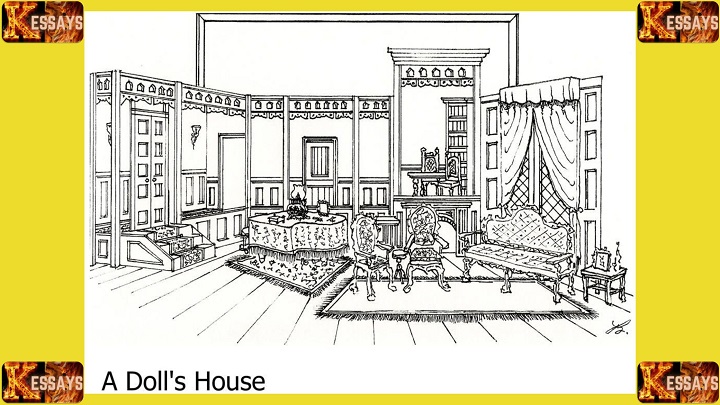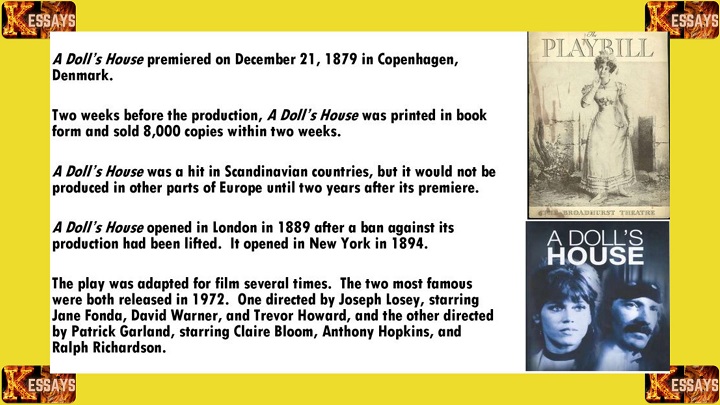Introduction
A Doll's House, written by Henrik Ibsen in 1879, is a play that explores the societal expectations placed upon women during the late 19th century. One aspect that often captivates audiences and critics alike is the significance of the play's set design. The set in A Doll's House serves as a powerful visual metaphor, reflecting the central themes of the play and unveiling the underlying symbolism and power dynamics at play. This essay will delve into the multifaceted significance of the A Doll's House set, exploring its role in highlighting gender roles, societal constraints, and the quest for liberation.
I. The Domesticity of the Set
A. The Parlor
A Restrictive Haven The parlor in A Doll's House serves as a significant element of the set, symbolizing the confinements imposed upon women within the domestic sphere. It is portrayed as a controlled and restricted space, emphasizing the limited roles and expectations assigned to women in society. The parlor represents a haven that is separate from the outside world, highlighting the isolation and lack of autonomy experienced by women during that era. The rigidly arranged furniture and decor within the parlor reflect the strict societal norms that confine women to their prescribed roles as homemakers and caretakers, devoid of personal agency and independence.
B. The Christmas Tree
Ornamental Representation of the
Helmer Family The Christmas tree in A Doll's House carries symbolic significance, functioning as a decorative element that reflects the superficiality and façade of the Helmer family's life. The tree is adorned with elaborate decorations and presents, representing the materialistic and performative nature of their lives. It symbolizes the emphasis on appearances and societal expectations, particularly in relation to the role of women as nurturers and providers of happiness within the domestic sphere. The Christmas tree acts as a metaphor for the Helmer family itself, presenting an idyllic image to the outside world while concealing the underlying discontent and disconnection within their relationships.

C. The Nursery
A Symbol of Repressed Maternity The presence of the nursery in the set of A Doll's House signifies the repressed maternity and stifled potential of women within the societal framework of the time. The nursery is a physical space dedicated to children, highlighting the expectation placed upon women to fulfill their maternal duties above all else. It represents the societal pressure for women to prioritize motherhood and neglect their individual aspirations and desires. The nursery also serves as a reminder of Nora's confinement within the role of a wife and mother, further reinforcing the gender roles and limitations imposed on women in their pursuit of personal fulfillment and self-actualization.
In summary, the domesticity of the set in A Doll's House plays a crucial role in reinforcing gender roles and highlighting the restrictive nature of women's lives during the late 19th century. The parlor symbolizes the confined space of women within the domestic sphere, the Christmas tree represents the performative and materialistic nature of their lives, and the nursery serves as a reminder of the repressed maternity and limited potential women faced. These elements collectively contribute to the exploration of societal expectations and the portrayal of the struggles faced by women in their quest for liberation and self-discovery.
II. The Set as a Microcosm of Society
A. The Helmer Residence: A Reflection of Middle-Class Life
The set design of the Helmer residence in A Doll's House serves as a reflection of middle-class life during the 19th century. The modest yet comfortable furnishings and decor portray the Helmers as a typical middle-class family, highlighting their social status and the societal expectations associated with it. The set depicts a conventional domestic environment, complete with tasteful furniture and decorations that align with their socioeconomic standing. This representation of the Helmer residence creates an atmosphere that reinforces the societal constraints and norms prevalent in their class, adding depth to the exploration of socioeconomic constraints.
B. The Locked Door: Restriction and Hidden Secrets
The locked door within the set design of A Doll's House serves as a powerful symbol of restriction and hidden secrets. It represents the barriers that prevent genuine communication and openness within the Helmer household. The locked door signifies the façade of harmony and happiness projected to the outside world while concealing the complexities and problems that exist within their marriage. It becomes a metaphor for the suppression of truth, individuality, and personal growth. The locked door also acts as a physical obstacle, further reinforcing the power dynamics and control that restrict the characters' freedom and expression.
C. The Staircase: Symbolic Struggle for Social Ascent
The staircase within the set design of A Doll's House symbolizes the characters' symbolic struggle for social ascent and acceptance. It represents the Helmers' desire to climb the social ladder and be recognized within their community. The staircase becomes a visual reminder of the societal expectations and the sacrifices the characters make in their pursuit of social status. It embodies the tension between the characters' desire for upward mobility and the constraints imposed upon them by their gender, class, and societal norms. The staircase serves as a metaphorical representation of the challenges and obstacles faced by individuals striving to transcend their predetermined roles and achieve recognition within a stratified society.
In summary, the set design in A Doll's House functions as a microcosm of society, reflecting the socioeconomic constraints that shape the characters' lives. The Helmer residence portrays middle-class life and the associated expectations, while the locked door symbolizes restriction and hidden secrets. The staircase represents the struggle for social ascent and acceptance, highlighting the challenges faced by individuals within a stratified society. These elements contribute to the exploration of societal constraints and power dynamics, further enriching the thematic depth of the play.

III. The Set as a Metaphor for Entrapment
A. The Cage-like Quality of the Set
The set design in A Doll's House often conveys a cage-like quality, symbolizing the entrapment and confinement experienced by the characters, particularly Nora. The arrangement of furniture, the enclosed spaces, and the restricted movements within the set all contribute to this metaphorical imprisonment. The cage-like quality represents the societal expectations and gender roles that restrict individuals, particularly women, from expressing their true selves and pursuing their own desires. It highlights the power dynamics at play, wherein women are confined to predetermined roles and limited autonomy within the patriarchal society.
B. The Picture of a Victorian Household
Superficial Harmony The set design of A Doll's House presents a picture of a Victorian household, characterized by an illusion of harmony and domestic bliss. The meticulously arranged furniture, the carefully chosen decorations, and the overall aesthetic create an atmosphere of superficial order and contentment. However, beneath the surface, the set hints at the underlying tensions and power dynamics that govern the relationships within the household. It reveals the façade of conformity and societal expectations, shedding light on the imbalance of power and the sacrifices made to maintain appearances.
C. The Window
A Symbol of Hope and Liberation The presence of a window within the set design of A Doll's House becomes a powerful symbol of hope and liberation. It serves as a metaphorical opening to the outside world and the possibilities beyond the confines of the domestic sphere. The window represents the desire for freedom and self-actualization, offering glimpses of a different life and challenging the established power dynamics. It becomes a focal point of liberation for Nora, who seeks to break free from societal expectations and forge her own path. The window signifies the potential for change and the quest for personal agency, providing a glimmer of hope amidst the otherwise restrictive environment.
In summary, the set design in A Doll's House acts as a metaphorical representation of entrapment and power dynamics. The cage-like quality emphasizes the confinement experienced by the characters, particularly women, within societal expectations. The picture of a Victorian household reveals the superficial harmony that masks underlying tensions and power imbalances. The window serves as a symbol of hope and liberation, offering a glimpse of a different life beyond the confines of societal constraints. Together, these elements contribute to the exploration of power dynamics and the pursuit of individual freedom within a restrictive society.

IV. The Evolution of the Set
A. The Set Transformations
Mirroring Character Development Throughout A Doll's House, the set undergoes transformations that parallel the evolution of the characters, particularly Nora. As the play progresses, subtle changes in the set design reflect the shifting dynamics and internal growth of the characters. These transformations symbolize the breaking of societal constraints and the pursuit of personal freedom. For instance, the gradual disarray of the parlor or the rearrangement of furniture signifies the characters' departure from established norms and their journey towards self-discovery.
B. The Door Slam
A Powerful Exit from Conformity The iconic door slam towards the end of A Doll's House represents a powerful exit from societal conformity and the liberation of the characters, particularly Nora. The door serves as a literal and symbolic threshold, marking the moment of decisive action and emancipation. Nora's departure through the door symbolizes her rejection of societal expectations and her refusal to be confined within prescribed gender roles. The door slam resonates with a resounding impact, signifying the breaking of chains and the assertion of personal autonomy.
C. The Empty Set
Embracing Ambiguity and New Beginnings In the final moments of A Doll's House, the empty set serves as a profound symbol of ambiguity and the potential for new beginnings. With Nora's departure, the set becomes vacant, devoid of the previous confines and expectations. The emptiness signifies the liberation and openness that comes with embracing uncertainty and embracing personal growth. The empty set represents the blank canvas upon which new narratives can be written, allowing for the exploration of new possibilities and individual agency.
In summary, the set design in A Doll's House undergoes significant changes that reflect the characters' journey towards freedom and self-discovery. The transformations of the set mirror the development of the characters, while the door slam represents a decisive exit from conformity. The empty set at the play's conclusion signifies the embrace of ambiguity and new beginnings. These elements contribute to the narrative arc of the play, highlighting the transformative power of individual agency and the pursuit of personal freedom within societal constraints.

Conclusion
The A Doll's House set serves as a compelling visual manifestation of the play's themes, inviting the audience to delve into the depths of gender roles, societal constraints, and the quest for liberation. Through its various components, such as the parlor, Christmas tree, and nursery, the set reinforces traditional gender roles and highlights the limitations imposed on women. Moreover, the set acts as a microcosm of society, representing socioeconomic constraints and hidden secrets.
It also serves as a metaphor for entrapment, with its cage-like quality and superficial harmony. However, as the play progresses, the set undergoes transformations that mirror the characters' journeys towards freedom, culminating in the powerful door slam that signifies the rejection of societal norms. Ultimately, the A Doll's House set's significance lies in its ability to visually and symbolically convey the complex dynamics between gender, power, and liberation, making it a timeless and thought-provoking theatrical experience.



